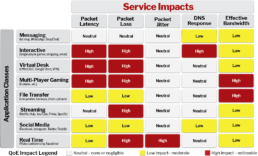January is the time of year when we tend to see a flurry of new year trends. Imagine the commotion in the airline industry when a 1989 Chicago Tribune headline read, “Experts predict that fax machines and phones will someday be joined by television screens in plane seat-backs”. When seat-back phones were first introduced, the average cost was $4.99 per minute. An airline industry analyst was quoted as saying, “Everybody wants their own phone. I think it`s a trend.” And what was the ultimate in showoff machinery? The mile-high facsimile machine.
Of course, this was before the Internet. By the early 2000’s a handful of major carriers were offering inflight Wi-Fi. In those early days, passengers could expect connections, at best, around 3 Mbps. Today, many airlines are delivering peak speeds closer to 70-100 Mbps, and some expect to deliver even faster speeds in the very near future.
When passengers hear “you are now free to use your personal electronic device” they expect that device to perform similarly to the way it does at home – whether they are shopping online or catching up with work emails or friends on social media. A handful of carriers are delivering streaming services for video but it’s just around the corner for the rest. The good news is that advancements in inflight connectivity (IFC), via either satellite or air-to-ground (ATG) technologies, are enabling airlines to offer more reliable service, due in part to increased speeds or throughput mentioned above. However, speed is just one component to delivering high-quality inflight Wi-Fi.
Do you really know what your passengers are experiencing?
To better understand the IFC experience, airlines will often survey passengers for insights. While surveys can be a great way to capture customer feedback, it may be too little too late given that two-thirds of passengers are likely to rebook with an airline that provides high-quality inflight Wi-Fi. Additionally, surveys don’t always pinpoint where issues lie, leaving the airline still unable to accurately resolve a problem.
WHAT'S AT STAKE?
REVENUE
- Ancillary inbound revenue for internet service
- Lost revenue from the refund after the customer complains about the service
LOYALTY
- Customer loyalty is positively connected to how satisfied a customer is with their experience
A better approach to understanding the inflight Wi-Fi experience is to independently measure the passenger experience while it is occurring. There are many factors that can impact the experience a passenger may have on their flight/device. For example, contrary to popular belief, internet speed has a relatively low impact on many online experiences, such as online shopping. Instead, it is the responsiveness of the server that hosts the online shopping site that impacts the expected performance. In a scenario where a user is frustrated with the service, the latency could be tracking at 50 milliseconds. In contrast, at home, that same user may be receiving latency metrics closer to 16 milliseconds with no noticeable issue.
This same general principle applies across different applications and various ways passengers use Wi-Fi, as noted in the application performance matrix below.

Predict and improve your IFC for a better passenger experience
To ensure your passengers aren’t flocking to other airlines and that you are providing the service your passengers expect, it is critical to look more closely at what is impacting the inflight connectivity experience. Understanding how passengers are being impacted enables an airline to tune their inflight Wi-Fi services for a prompt resolution and delivery of the best possible passenger experience.
NetForecast has been a leading participant in the APEX Connectivity Working Group’s Passenger Experience Subcommittee. To learn more about how application sensitivity impacts internet performance, read the recently published paper, Evaluating the Passenger Connectivity Experience, which can be viewed on our website at NetForecast.com/audit-reports.
